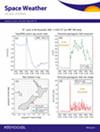A Transfer Learning Method to Generate Synthetic Synoptic Magnetograms
IF 3.7
2区 地球科学
引用次数: 0
Abstract
Current magnetohydrodynamics (MHD) models largely rely on synoptic magnetograms, such as the ones produced by the Global Oscillation Network Group (GONG). Magnetograms are currently available mostly from the front side of the Sun, which significantly reduces the accuracy of MHD modeling. Extreme Ultraviolet (EUV) images can instead be obtained from other vantage points. To investigate the potential, we explore the possibility of using EUV information from the Atmospheric Imaging Assembly (AIA) to directly generate the input for the state-of-the-art 3D MHD model European Heliospheric FORecasting Information Asset (EUHFORIA). Toward this goal, we develop a method called Transfer-Solar-GAN which combines a conditional generative adversarial network with a transfer learning approach to overcome training data set limitations. The source domain data set is constructed from multiple pairs of the central portion of co-registered AIA and Helioseismic and Magnetic Imager (HMI) line of sight (LOS) full-disk images, while the target domain is constructed from pairs of portions of AIA and GONG sine-latitude synoptic maps that we call segments. We evaluate Transfer-Solar-GAN by comparing modeled and measured solar wind velocity and magnetic field density parameters at the L1 Lagrange point and along the Parker Solar Probe (PSP) trajectory which were determined with EUHFORIA using both empirical GONG and artificial-intelligence (AI)-synthetic synoptic magnetograms as inputs. Our results demonstrate that the Transfer-Solar-GAN model can provide the necessary information to run solar physics models by EUV information. Our proposed model is trained with only 528 paired image segments and enforces a reliable data division strategy.生成合成同步磁图的迁移学习方法
目前的磁流体动力学(MHD)模型主要依赖于同步磁图,如全球涛动网络组(GONG)制作的磁图。磁图目前主要来自太阳正面,这大大降低了 MHD 模型的准确性。而极紫外(EUV)图像则可以从其他有利位置获得。为了研究其潜力,我们探索了利用大气成像组件(AIA)的极紫外信息直接生成最先进的三维 MHD 模型欧洲日光层重力铸造信息资产(EUHFORIA)输入的可能性。为实现这一目标,我们开发了一种名为 Transfer-Solar-GAN 的方法,该方法将条件生成对抗网络与迁移学习方法相结合,以克服训练数据集的限制。源域数据集是由多对共同注册的 AIA 和太阳地震与磁成像仪(HMI)视线(LOS)全盘图像的中心部分构建的,而目标域则是由 AIA 和 GONG 正弦纬度同步图的多对部分构建的,我们称之为片段。我们通过比较 L1 拉格朗日点和帕克太阳探测器(PSP)轨迹上的太阳风速度和磁场密度参数,对 Transfer-Solar-GAN 进行了评估,这些参数是使用经验 GONG 和人工智能(AI)合成的同步磁图作为输入,通过 EUHFORIA 确定的。我们的研究结果表明,Transfer-Solar-GAN 模型可以提供运行太阳物理模型所需的 EUV 信息。我们提出的模型仅用 528 个成对图像片段进行了训练,并执行了可靠的数据分割策略。
本文章由计算机程序翻译,如有差异,请以英文原文为准。
求助全文
约1分钟内获得全文
求助全文

 求助内容:
求助内容: 应助结果提醒方式:
应助结果提醒方式:


